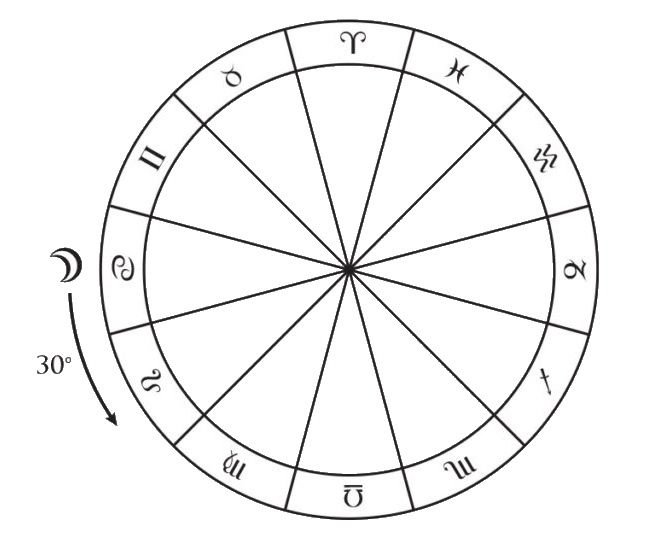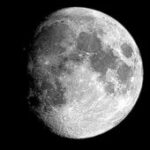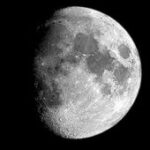
NEW MOON

NEW CRESCENT MOON

FIRST QUARTER MOON

WAXING GIBBOUS MOON

FULL MOON

WANING GIBBOUS MOON

LAST QUARTER MOON

BALSAMIC MOON
The Moon Phases
The stages in the planting cycle, from the seed in the ground to the harvest, are symbolized by these eight phases. They also match important events in the yearly cycle, starting with the Winter Solstice.
|
PHASE
|
NAME
|
SEASONAL FESTIVAL
|
DESCRIPTION
|
KEYWORD
|
|---|---|---|---|---|

|
New Moon
|
Winter Solstice
|
Denotes the new moon or a soli-lunar arc in the range 0°-45°
|
Beginnings
|

|
New Cresent Moon
|
Imbolc, Candlemas
|
Denotes a waxing crescent moon or a soli-lunar arc in the range 45°-90°
|
Initiative
|

|
First Quarter Moon
|
Spring Equinox
|
Denotes a first quarter moon or a soli-lunar arc in the range 90°-135°
|
Growth
|

|
Waxing Gibbous Moon
|
Beltane, May Day
|
Denotes a waxing gibbous moon or a soli-lunar arc in the range 135°-180°
|
Perfection
|

|
Full Moon
|
Summer Solstice
|
Denotes a full moon or a soli-lunar arc in the range 180°-225°
|
Clarity
|

|
Waning Gibbous Moon
|
Lammas, Harvest Festival
|
Denotes a waning gibbous moon or a soli-lunar arc in the range 225°-270°
|
Sharing
|

|
Last Quarter Moon
|
Fall Equinox
|
Denotes a last quarter moon or a soli-lunar arc in the range 270°-315°
|
Decline
|

|
Balsamic Moon
|
Samhain, Halloween
|
Denotes a waning crescent moon or a soli-lunar arc in the range 315°-360°
|
Preparation
|
|
VC
|
Void of Course
|
|
When the Moon is void of course, it is considered to be in a state of transition.
|
Confusion
|

New Moon

This phase occurs when the Moon and Sun align in the same sign. It marks the start of the planting cycle, when the seed sprouts a delicate shoot under the soil. This is a precarious moment, with the outcome still uncertain. This phase also relates to the Winter Solstice in the seasonal cycle. In this phase, you have the opportunity to shape the world according to your vision. You tend to have a subjective, even egocentric, perspective. You feel that you are not bound by the rules others make, you create your own rules that suit the current situation. For instance, you may challenge why something has to be done in a certain way, and you won’t accept the explanation that it’s how it has always been done.
New Crescent Moon

This phase is when the Moon grows brighter and reaches the midpoint between New and First Quarter Moon. It is like the young organism that has to survive in a harsh and unfriendly environment. This phase matches the seasonal holiday of Candlemas, around February 1st, halfway between the Winter Solstice and the Spring Equinox. In this phase, you are eager to pursue new ideas and impulses, even if you face opposition. Your main goal in life is to make new forms a reality and a separate existence from the old way of being. You are fully committed to this purpose, but you may also feel the challenge of the status quo, since the older forms will not give up easily.
First Quarter Moon

This phase signifies the waxing and squaring of the Moon and the Sun. It corresponds to the Vernal Equinox in the seasonal cycle and the stage of rapid growth in the planting cycle, when the organism sprouts leaves and branches. In this phase, you are determined to create new structures for yourself and society, and you work hard to achieve your goals of bringing new forms into reality, despite any resistance. This progress involves some struggle, as the old does not give way easily.
Waxing Gibbous Moon

This phase occurs when the Moon is waxing and halfway between First Quarter and Full Moon. It symbolizes the time in the planting cycle when the bud starts to form, holding the promise of the flower within. This phase is also associated with the cross-quarter holiday of Beltane, which was celebrated around May 1st (or May Day), halfway between the Vernal Equinox and the Summer Solstice. In this phase, you feel a strong urge to achieve your goals, with a keen and meticulous mind. You have a passion for creating and refining new forms and structures. You are dissatisfied with outdated ideas, or any reluctance to embrace the new element that you think needs to be improved to reach its full potential.
Full Moon

This phase occurs when the Moon and Sun are on opposite sides of the Earth, facing each other. It matches the time when the flower comes out in the planting cycle. It also symbolizes the Summer Solstice, the longest day of the year. In this phase, you can see how your work affects others. You act with clear vision, not blind faith, and you are objective. You listen to others and know how to influence them. Your work matters to you only when you share it with others.
Waning Gibbous Moon

This phase marks the waning of the Moon, which is halfway between Full and Last Quarter Moon. It corresponds to the first appearance of the plant’s fruit in the planting cycle. It also symbolizes the cross-quarter holiday of Lamas, celebrated around August 1st, midway between the Summer Solstice and the Fall Equinox. In this phase, your life mission is to illuminate. You have gained knowledge of what has been achieved in a certain field of endeavour, and you want to share it with others. You represent the culmination of the whole planting cycle, as the symbolic fruit of the garden’s life.
Last Quarter Moon

This phase marks the waning of the Moon and its square aspect with the Sun. It is analogous to the end of the planting cycle, when the crop is harvested and the remaining plant parts start to decay and return to the soil, while the fruit also prepares its seeds for the next planting. This phase corresponds to the autumnal equinox in the seasonal cycle. In this phase, you exemplify the dismantling of the old structures to make way for the new ones. You experience a “crisis of consciousness” that makes you dissatisfied with the current state of affairs and eager to change it. You have a deep discontent with the existing social structures in your environment.
Balsamic Moon

This phase marks the waning of the Moon, halfway between Last Quarter and New Moon. It is the time when the seed matures, while the rest of the plant withers away. The plant’s energy becomes concentrated in the seed, ready for the next cycle. This phase corresponds to Halloween in the seasonal progression, midway between the Fall Equinox and the Winter Solstice. At this time, the veil between worlds is thin, and the spirits of the dead roam the earth. You are drawn to a faintly perceived distant reality during this phase, and you may feel somewhat detached from the existing social structure. You are like the withering plant, sharing the wisdom gained from the past experience, in an attempt to bring its essence into the new form that is emerging. You have a sense of purpose in helping to pave the way for something new to emerge, even though you may never see clearly what that new social structure will be. You need to be independent, to break free from the remnants of the dead past and to proclaim your message as a herald of the coming new dawn.
Void of Course

“Void of Course” is a term used in astrology to describe a period when the Moon is transitioning from one zodiac sign to the next without forming any major aspects with other planets. In astrology, the Moon represents emotions, instincts, and the subconscious mind, while aspects are angular relationships between celestial bodies that influence their energy and interactions.
When the Moon is void of course, it is considered to be in a state of transition, where its energy is less focused and may lack direction or purpose. This period is typically seen as a time when it’s not ideal for initiating new projects, making important decisions, or taking significant actions. Instead, it’s often recommended to focus on routine tasks, reflection, and relaxation during void of course periods.
The length of a void of course period can vary, lasting anywhere from a few minutes to over a day, depending on the speed of the Moon’s movement and its aspects with other planets. Astrologers typically track void of course periods and include this information in astrological forecasts and horoscopes to help individuals navigate the ebb and flow of cosmic energies. While some astrologers place significant importance on void of course periods, others may interpret their significance differently or consider them less influential. As with all astrological concepts, interpretations may vary based on individual perspectives and beliefs.








































































